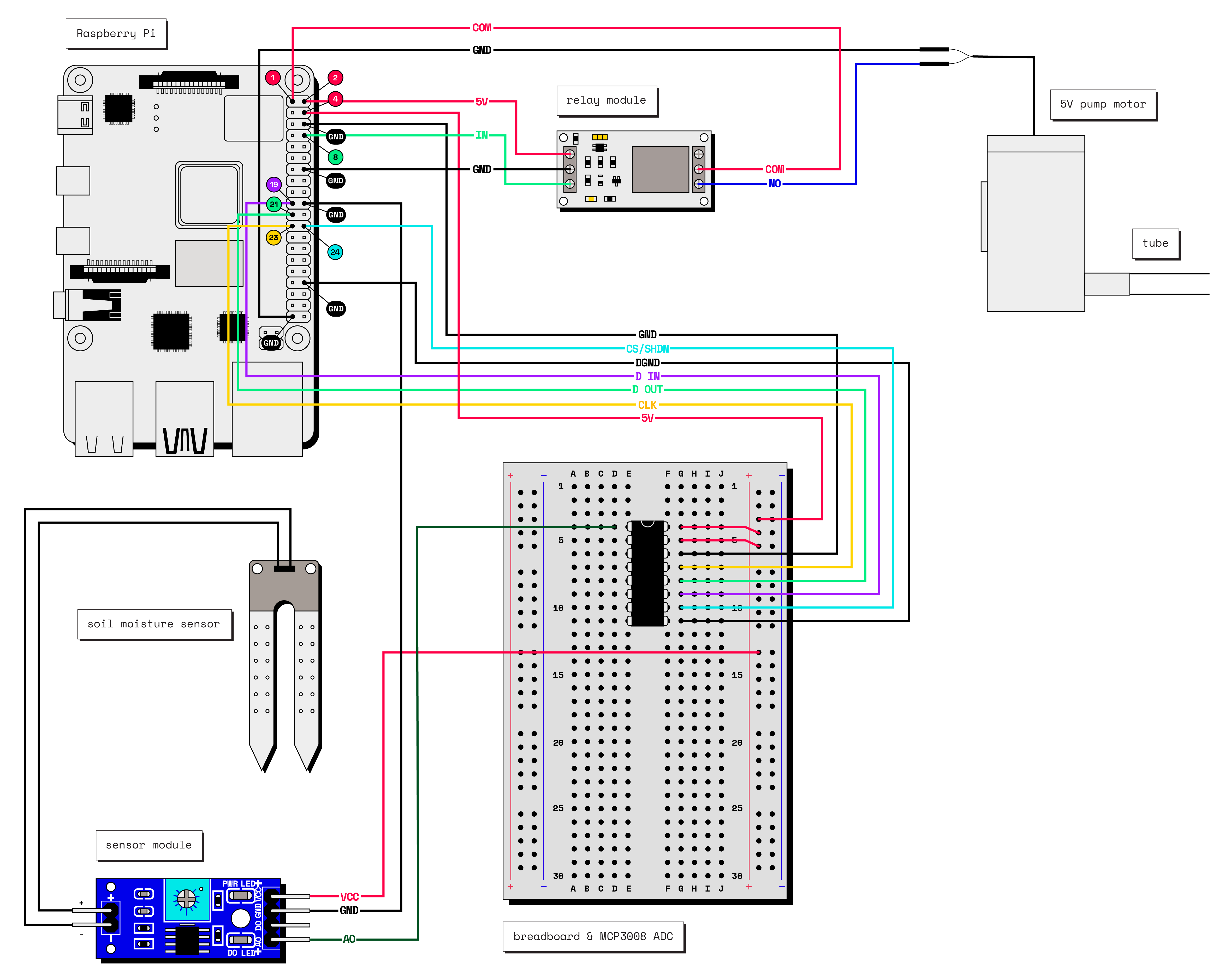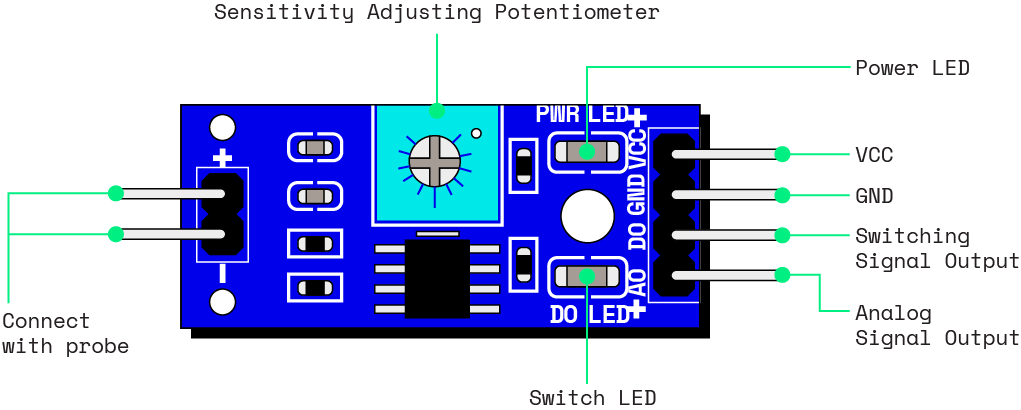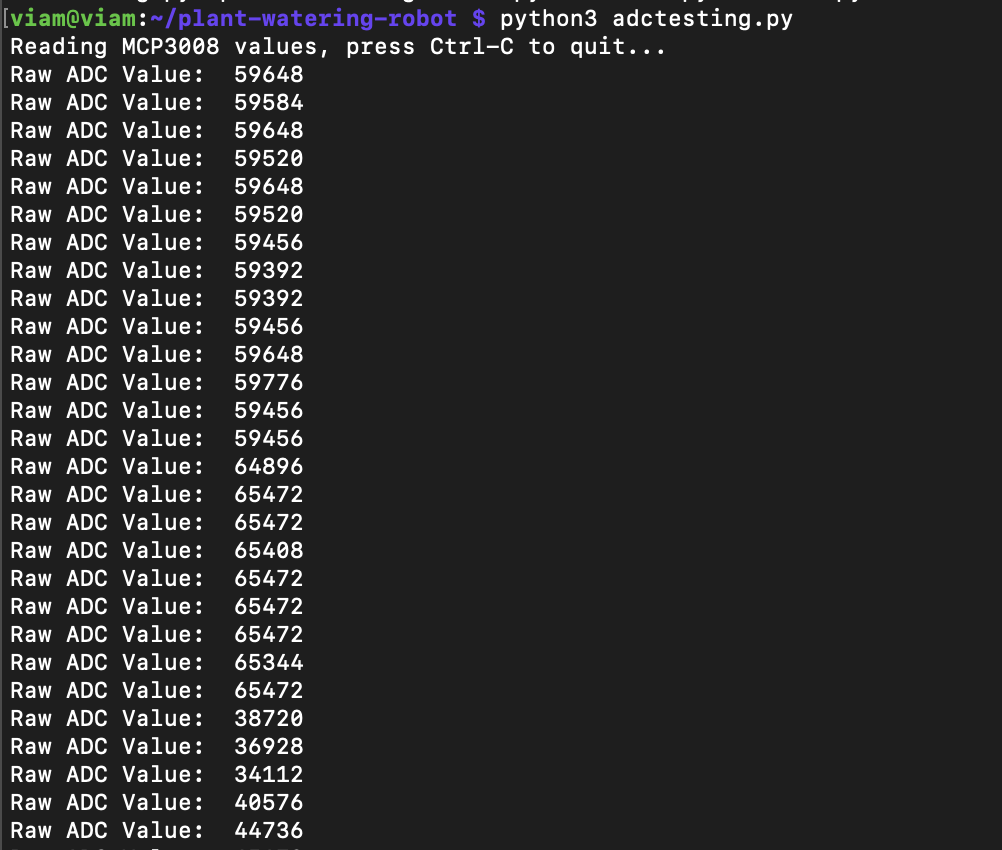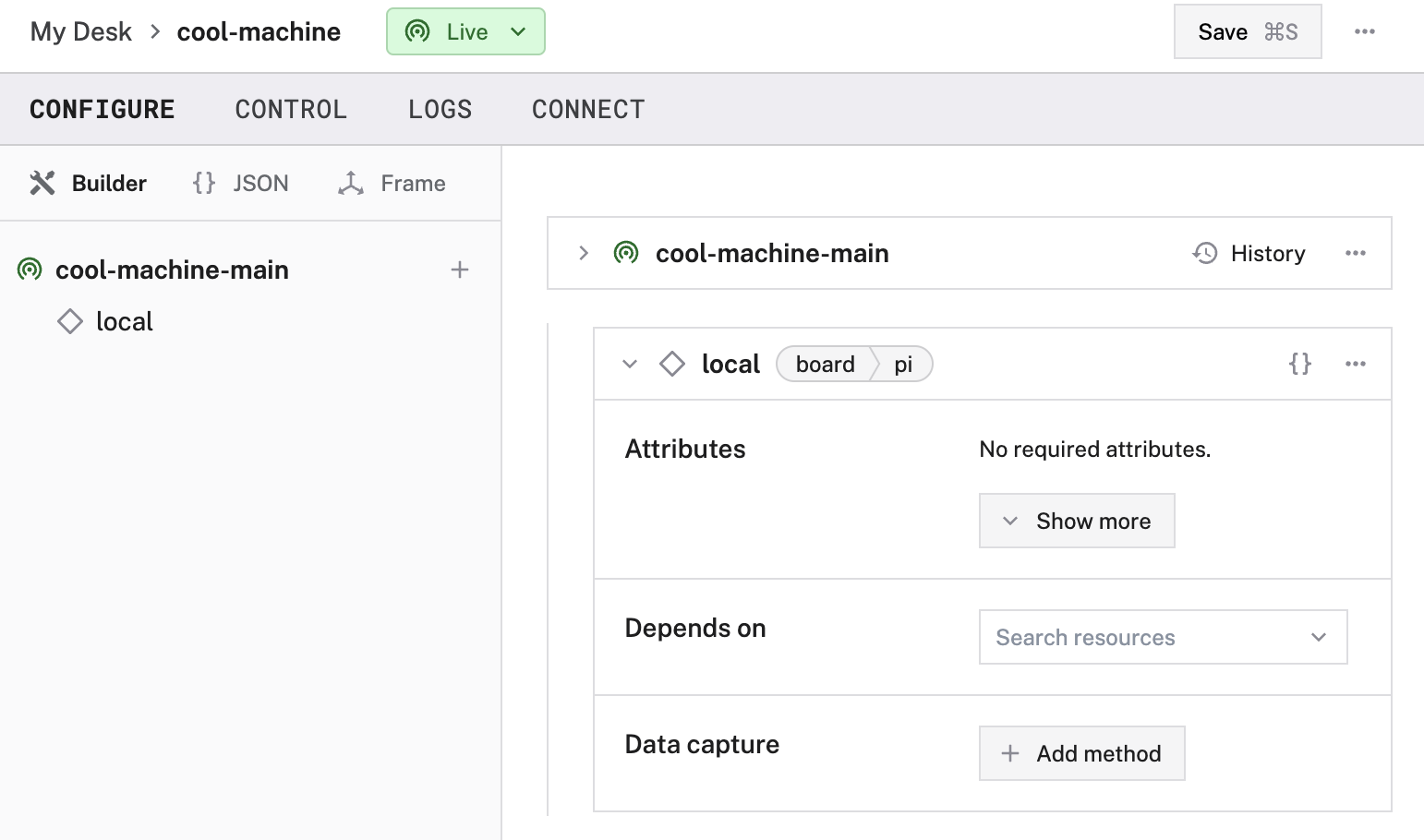Plant Watering Robot with a Raspberry Pi

Building a useful robot doesn’t have to require complicated code or expensive equipment. With a Raspberry Pi and some cheap, basic hardware, you can keep your plants healthy and happy from anywhere in the world!
Follow this tutorial to learn how to set up an automatic plant watering system:
- Complete the physical assembly and wiring.
- Create and connect to the robot, and configure your robot’s components.
- Configure the ADC as a module from the registry.
- Write code utilizing the Viam Python SDK to control the plant watering robot.
You can also follow a simplified version of this tutorial in this video: it eliminates the need for the ADC and the breadboard, instead using the digital pin of the moisture sensor to get “high” and “low” readings and to turn a relay on and off. You can start with this simple version and then add the ADC to make your machine more accurate!
The tutorial uses the following hardware, but you can adjust it as needed:
- A Raspberry Pi 3B or 4B with SD card and 5V USB power supply
- A resistive soil moisture sensor
- A 5V mini water pump with clear vinyl tube
- A MCP3008 ADC
- A one channel relay switch
- A breadboard
- Assorted breadboard jumper wires, including wires with alligator clips
- A planter box or flower pot
- A water container
- A screwdriver
Before starting this tutorial, follow the Raspberry Pi Setup Guide to prepare your Pi to run viam-server.
Connect your Pi to its power supply to power it on.
Make sure your Pi is flashed with a Viam-compatible operating system, and that you are able to SSH into it.
Set up your plant watering robot
Before programming the Pi to make the plant watering robot functional, you need to physically set up the plant watering robot by wiring the different components together. You will set up the robot to receive signals from the resistive soil moisture sensor and signal to the pump when it is time to pump water from the water’s container to the plant’s container.
Full wiring diagram
Refer back to this diagram as you complete the steps to wire your hardware.

Wire your ADC
The analog-to-digital converter (ADC) converts the resistive soil moisture sensor’s analog readings to digital signals that can be processed by your Pi, which expects digital signals to come to it through its GPIO pins.
Start by wiring your ADC to your Raspberry Pi board.
You can find a Raspberry Pi pinout diagram at pinout.xyz. Reference the following pinout diagram for your MCP3008 analog-to-digital converter:

Tip
The half circle shown in the pinout diagram above should be physically present on your ADC. Use this to orient the ADC to determine the location to insert your wires.
Insert the MCP3008 into your breadboard so that it bridges both sides of the divide. Then, use the rows on the side of your MCP3008’s pins and the GPIO pins on your Pi to connect the pins with wires as follows:
| MCP3008 ADC Pin | Raspberry Pi Pin |
|---|---|
| VDD | 5V |
| VREF | 5V |
| AGND | GND |
| DGND | GND |
| CLK | SCLK |
| DOUT | MISO |
| DIN | MOSI |
| CS/SHDN | 24GPIO8 |
Use an additional wire to wire Raspberry Pi pin 4 (a 5 volt power pin) to the power rail of the breadboard (the red plus sign column). This brings the 5V power output from the Raspberry Pi to the ADC and the sensor.
Wire your resistive soil moisture sensor
Next, wire your resistive soil moisture sensor to your Pi and ADC.
Reference this diagram of the blue module part of the sensor:

Start by connecting the female jumper wires at the end of the sensor prongs to the blue module where the diagram shown above is labeled “Connect with Probe.” Be careful of the positive and negative sides, and make sure to match them correctly.
Then, wire the rest of the pins on the module to the Pi and ADC as follows:
| Pi | ADC | ||||||||||
|---|---|---|---|---|---|---|---|---|---|---|---|
|
|
Put the soil moisture sensor inside of the container holding your plant.
Wire your pump
Now, wire and power your pump and relay module to complete your hardware setup:
- Attach an alligator wire clip to your 5V pump motor’s positive wire, and connect it to the NO pin on relay module. NO stands for normally open, which will keep the circuit open unless the pin is triggered.
- Attach another alligator wire clip to your 5V pump motor’s negative wire, and connect it to pin 39 (ground) on the Raspberry Pi.
- Connect the COM (common) pin on the relay to pin 1 (3.3V) on the Pi.
- Connect the 5V pin on the relay to pin 2 (5V) on the Pi.
- Connect the GND pin on the relay to pin 14 (ground) on the Pi.
- Connect the IN pin on the relay to the pin 8 (GPIO 14) on the Pi.
Tip
To complete the steps, insert the ends of the jumper wires into the pin gates on the relay module and tighten the screws on these gates with your screwdriver to close the wires inside.
Program your plant watering robot
Enable SPI on your Pi
Now that you have wired your ADC and moisture sensor, make sure that the Serial Peripheral Interface (SPI) is enabled on your Pi. Enabling this protocol is necessary to allow the Pi to communicate with the moisture sensor peripheral.
SSH into your Pi and run the following command:
sudo raspi-config
Once the raspi-config interface is open, navigate to Interface Options:

Then, select SPI:

Now, select Yes to enable SPI:

Finally, select Finish.
Restart your Pi using sudo reboot to make these changes take effect.
Test your soil moisture readings on your Pi
Next, install the Adafruit ADC library Adafruit_CircuitPython_MCP3xxx on your Pi.
Before installation, make sure any packages on your Pi are up to date:
sudo apt update
sudo apt upgrade
Make sure you have pip installed for Python 3:
pip --version
If not, run the following command:
sudo apt install python3-pip
Run the following command while connected to your Pi with SSH to install Adafruit_CircuitPython_MCP3xxx:
sudo pip3 install adafruit-circuitpython-mcp3xxx
Create a new directory for your plant watering robot’s files and navigate to this directory in your terminal session. For example, run the following commands:
mkdir plant-watering-robot
cd plant-watering-robot
After navigating to this directory, create a new Python file called
touch adctesting.py
nano adctesting.py
Now, add the following Python code to
import time
import busio
import digitalio
import board
import adafruit_mcp3xxx.mcp3008 as MCP
from adafruit_mcp3xxx.analog_in import AnalogIn
# Create the SPI bus
spi = busio.SPI(clock=board.SCK, MISO=board.MISO, MOSI=board.MOSI)
# Create the cs (chip select)
cs = digitalio.DigitalInOut(board.D8)
# Create the MCP3008 object
mcp = MCP.MCP3008(spi, cs)
# Create an analog input channel on Pin 0
chan = AnalogIn(mcp, MCP.P0)
print('Reading MCP3008 values, press Ctrl-C to quit...')
while True:
print('Raw ADC Value: ', chan.value)
time.sleep(1)
Run the code as follows:
sudo python3 adctesting.py
Tip
If running this code returns ImportError: No module named busio, try again after reinstalling adafruit-blinka:
sudo pip3 install --force-reinstall adafruit-blinka
Now, you should see the moisture sensor values outputted by the MCP3008.
Test your sensor by putting it in air, water, and different soils to see how the values change to determine your baseline for wet and dry values.

Configure the components of your robot in the Viam app
Add a new machine in the Viam app.
Then follow the setup instructions to install viam-server on the computer you’re using for your project and connect to the Viam app.
Wait until your machine has successfully connected.
Then, navigate to the the CONFIGURE tab of your new machine’s page in the app.
First, add your Pi as a board component:
Click the + icon next to your machine part in the left-hand menu and select Component.
Select the board type, then select the pi model.
Enter a name for your board and click Create.
This tutorial uses the name local.

{
"components": [
{
"name": "local",
"model": "pi",
"type": "board",
"namespace": "rdk",
"attributes": {},
"depends_on": []
}
]
}
Configure the ADC as a module from the registry
Resources refer to the different components and services Viam provides for robots to use.
Components refer to types of hardware, and each component’s built-in models support the most common models of this hardware.
For example, the sensor component has an ultrasonic model built in for the ubiquitous ultrasonic sensor.
However, there are many different types of sensors used for sensing different things across the Internet of Things. Although the resistive soil moisture sensor is not currently one of Viam’s built-in models, you can add an analog-to-digital-converter (ADC) as a module and use it to get readings from the moisture sensor.
A module provides one or more modular resources, which add resource types (components and services) or models that are not built into Viam. A module can be added to your robot from the Viam registry.
The Viam registry allows hardware and software engineers to collaborate on their robotics projects by writing and sharing custom modules with each other. You can add a module from the Viam registry directly from your robot’s CONFIGURE tab in the Viam app, using the + (Create) button.
Add the mcp300x-adc-sensor module to your robot in 3 steps:
Go to your machine’s CONFIGURE tab. Click the + icon next to your machine part in the left-hand menu and select Component.
Search for
mcp300xand selectsensor / mcp300x. Click Add module.Give your module a name of your choice. We used the name
sensor.Click Create to add this module to your machine.
Find your module’s card on the CONFIGURE page. In the attributes field, add the necessary attributes as
"channel_map"and"sensor_pin". For example, if you have a moisture sensor on channel 0, and yoursensor_pinis 8, your configuration should look like this:{ "channel_map": { "moisture": 0 }, "sensor_pin": 8 }
Save your config by clicking Save in the top right corner of the page.
This module allows you to get multiple readings at the same time from different channels of the ADC sensor.
If you wire and configure another sensor, such as a temperature sensor on channel 1, you can add the sensor to the "channel_map" and get a reading from it.
Info
If you would like to see how the module works, you can find its code on GitHub.
Now that you have set up your robot, you can put the suction tube of your pump into the water cup, and the output tube into the plant!
Add Python control code
Follow these instructions to start working on your Python control code:
Navigate to your machine’s page in the Viam app, and click on the CONNECT tab and the Code sample page.
Select Python as the language.
Follow the instructions shown under step 1 on that page to install the SDK.
Then, under step 2 on that page, click the copy icon to copy the generated code sample, which establishes a connection with your robot when run.
API key and API key ID
By default, the sample code does not include your machine API key and API key ID. We strongly recommend that you add your API key and API key ID as an environment variable and import this variable into your development environment as needed.
To show your machine’s API key and API key ID in the sample code, toggle Include secret on the CONNECT tab’s Code sample page.
Caution
Do not share your API key or machine address publicly. Sharing this information could compromise your system security by allowing unauthorized access to your machine, or to the computer running your machine.
Paste this code sample into a new file in the
plant-watering-robotdirectory you created on your Pi.Name the file
plant-watering-robot.py , and save it.
For example, run the following commands on your Pi to create and open the file:
cd plant-watering-robot
touch plant-watering-robot.py
nano plant-watering-robot.py
Now, you can add code into
To start, add your system logic code into the main() function of the program.
Use the Viam board and sensor API methods to read from the moisture sensor and control the pump’s voltage with PWM as a GPIO pin.
You can get your components from the robot like this:
# Note that this name, `sensor`, is defined when you add the mcp300x module
sensor = Sensor.from_robot(robot=robot, name='sensor')
# Note that this name, `local`, is defined when you add the board
local = Board.from_robot(machine, "local")
And you can add your system logic to run continuously like this:
while True:
# Get the moisture sensor's readings
readings = await sensor.get_readings()
soil_moisture = readings.get('moisture')
# Calculate average moisture reading from the list of readings, to account
# for outliers
avg_moisture = sum(soil_moisture) / len(soil_moisture)
# If the average moisture reading is greater than 60000, trigger pump
# watering
if (avg_moisture > 60000):
print('this plant is too thirsty! giving it more water')
# Get the GPIO pin with PWM output (pin number 8) the water pump is
# wired to on the board through the relay's IN wire
pwm_pin = await local.gpio_pin_by_name(name="8")
# Run the water pump
# Set the duty cycle to .8, meaning that this pin will be in the
# high state, powering the pump motor, for 80% of the duration of the
# PWM interval period
await pwm_pin.set_pwm(duty=0.8)
# Wait for 15 seconds
print('watering')
time.sleep(15)
# Stop the pump by setting the duty cycle to 0%
await pwm_pin.set_pwm(duty=0.0)
# Wait 60 seconds so that the water can soak into the soil a bit before
# trying to water again
print('waiting a little bit for water to soak in')
time.sleep(60)
Tip
Make sure to import time at the beginning of your version of sleep()!
Also, make sure to import viam.components.sensor.
Save your
sudo python3 plant-watering-robot.py
To tinker this example code to work best for you, determine at what analog value from the soil moisture readings you want to water your plant, as your thirsty plant’s average moisture reading might differ from our example value of 60000.
Also, consider how often you would like to check the moisture levels of the plant, and how long the plant should be watered.
Next steps
Now that you have created your automatic plant watering system with a resistive soil moisture sensor, you can easily use Viam to automate other aspects of your garden. For example, you can use a light sensor or a temperature sensor, and get readings from other channels of the MCP3008!
You could set up data capture and graph your sensor data, or create your own custom Typescript dashboard to display your sensor data.
If you build something based on this please share it in our Community Discord - we’d love to see it.
Was this page helpful?
Glad to hear it! If you have any other feedback please let us know:
We're sorry about that. To help us improve, please tell us what we can do better:
Thank you!